UCLA alumna, filmmaker fuses documentary with narrative in ‘Below Dreams’

UCLA alumna Garrett Bradley used interviews she had with passengers on Greyhound buses as the material for her film “Below Dreams.” The film will be screened in select L.A. theaters from Friday to Wednesday.
(Courtesy of Milena Pastreich)
By Ruhee Patel
April 9, 2015 12:52 a.m.
On a 37-hour bus ride from New York to New Orleans, Garrett Bradley held interviews with fellow passengers around her age. The conversations she had during that drive eventually culminated in her first feature film, “Below Dreams.”
The UCLA alumna said she began these interviews on the Greyhound buses while on a break from school, and that at the time, she didn’t know what she was going to do with the material she acquired or that she would eventually transcribe the recordings and turn them into a film script.
Bradley first joined the master of fine arts directing program in the School of Theater, Film and Television in 2007. Her film was screened at several film festivals last year, including the 2014 Tribeca Film Festival and 2014 New Orleans Film Festival and now will be released in select L.A. theaters from Friday to Wednesday and on video on demand April 21.
After writing the script, Bradley spent about a year and a half casting people based in New Orleans through Craigslist and then adapted some of the script to fit the real life experiences of those she casted.
“‘Below Dreams’ was a response to a dialogue that exists now about millennials, about my generation,” Bradley said. “It was a matter of showing the lives of people who are not really being spoken about or (aren’t) visible in popular culture.”
“Below Dreams” focuses on the lives of three people in their 20s in New Orleans and because the script was tailored to fit the lives of the actors, it was shot in a mixture of documentary and narrative styles. The film follows Leann (Leann Miller), a single mother of four, Jamaine (Jamaine Johnson), an unemployed man trying to find a job, and Elliott (Elliott Ehlers), a privileged college graduate searching for a woman.
In addition to writing the script for “Below Dreams,” Bradley also directed and edited the film.
“It was difficult, but I like to think of it as necessary because it helped me become a better filmmaker,” Bradley said.
Bradley said, at its core, “Below Dreams” is about the fact that struggle can’t be quantified and that everybody deals with challenges that are all equally valid, no matter where they come from.
“We can start to see how privilege, class and educational background play a huge rule in the most minute details of our life all the way down to when you are taking the bus,” Bradley said. “How do you get from the bus station to the place that you’re going?”
In the beginning of the film, Leann is denied a taxi and is forced to walk from the bus stop to an ice cream shop to get food for her children while she waits for her mother. On the other hand, Elliott immediately manages to find people to give him a ride at the same bus stop.
“I wanted to show how somebody (like Elliott) who has privilege can sort of float through space in a way that people who don’t (have privilege) can’t,” Bradley said. “That was important – creating a space for us to see that diversity that exists in this generation without making a judgment.”
Cinematographer and alumna Milena Pastreich said she first met Bradley when the two were studying at UCLA. She said, for the most part, her role was as the documentary cinematographer, while the other cinematographer, Brian C. Miller Richard, focused more on the scripted scenes.
“I would say (the documentary and narrative style) is Bradley’s aesthetic. She’s very much into that line between documentary and narrative and not really knowing (where it is); even when we were shooting that line was blurred a lot,” Pastreich said. “I think we just chose to reflect that in the visual style of the film as well.”
Miller Richard said the crew chose to film from the perspective of the camera rather than framing the actors up as a picture and showcasing them.
“I think that’s what gives it a lot of the documentary feeling,” Miller Richard said. “The camera is participating with our characters. It gave it a lot of life and helped build a lot of sympathy for the characters because you felt like you were going along on their journey with them.”
Miller Richard said Bradley had a strong vision of what she wanted and, in particular, kept reminding him “don’t make it beautiful.” Instead, he said Bradley urged the crew to work with the reality of what was happening.
“On a less personal level, (this film’s release) proves that there is a need for a more diversified experience,” Bradley said. “It proves that there is a demand and an interest for people who aren’t necessarily ‘popular.'”


